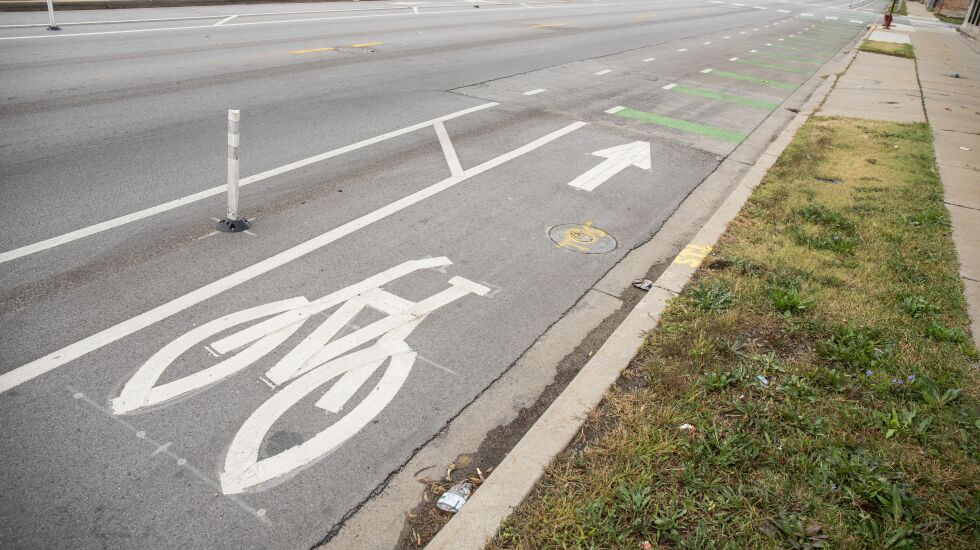
Chicago motorists who block bus lanes, bike lanes. crosswalks or loading zones might soon get nailed by surveillance cameras installed on CTA buses, “city vehicles,” light poles and other property pinpointed by City Hall.
Nearly 20 years after a CTA experiment with bus surveillance cameras failed miserably, Mayor Lori Lightfoot wants to try it again and then some in a designated downtown area that has the “highest concentration of serious crashes, traffic congestion, public transit service, pedestrian and commercial activity in Chicago.”
At Wednesday’s City Council meeting, Lightfoot joined forces with downtown alderpersons Brian Hopkins (2nd) and Brendan Reilly (42nd) on a groundbreaking ordinance that would plunge Chicago deeper into the Big Brother world of video surveillance and automated ticketing.
It calls for creating a pair of pilot programs — “Smart Streets” and “Smart Loading Zones” — that use cameras to nail wayward motorists. Both zones would stretch from Lake Michigan to Ashland Avenue and North Avenue to Roosevelt Road.
“These two pilots are aimed at encouraging better behavior behind the [wheel]. That’s really what we’re fundamentally about. We want to change driver behavior to make sure our streets are safer,” Lightfoot told a news conference after the Council meeting.
Transportation Commissioner Gia Biagi called the ordinance an “important step” toward providing speedier, more reliable and efficient CTA bus service and making downtown streets safer for pedestrians and cyclists alike.
The first two-year pilot would authorize the city to ticket registered vehicle owners by mail for parking in bike lanes, bus lanes, crosswalks and bus stops. The second would use “license-plate reading camera technology” to more efficiently ticket drivers or companies who double-park or park too long in commercial loading zones.
“It’ll discourage drivers from illegally parking in places that put our most vulnerable users at risk: folks on bikes, folks walking, folks in wheelchairs. These are the points of vulnerability. So we‘re doing everything we can to make it safe,” Biagi said.
“The pilot will also promote reliable and accessible bus service ... by deterring parking in bus-only lanes or at designated bus stops. One driver illegally parked in a dedicated bus lane creates slowdowns for the passengers on the bus, for the folks who are waiting for the bus, for the cars behind that bus trying to get through. It makes bus trips longer and less predictable.”
Cameras mounted on the exterior of CTA buses and other public transit vehicles, city vehicles and light poles will be used to record offenses. Citations would hit mailboxes no sooner than 30 days after the system is installed. Every offending motorist would get one warning notice before being ticketed.
Biagi noted that traffic fatalities have risen “at an alarming rate” since the start of the pandemic for a “range of factors” that include “bigger than ever” vehicles and motorists who got used to speeding through emptier streets during the stay-at-home shutdown.
“It’s critically important that we don’t leave any tools in the toolbox. We need them all to keep our streets safe,” she said.
Christina Whitehouse, founder of the advocacy group Bike Lane Uprising, said any crackdown that prevents motorists from “illegally blocking and driving in bike lanes” would be welcomed by the biking community. City officials and employees are the “most egregious” offenders, she said.
But Whitehouse contended illegal construction sites should also be part of the crackdown and commercial vehicles should be fined at a higher rate than private citizens.
“We’ve seen an all-time record high of people being killed biking. We’re seeing rates of people being killed almost double what they used to be just a couple of years ago. And it’s so bad that we don’t even talk about critical injuries anymore,” Whitehouse said.
London pioneered the idea of using exterior bus cameras to nail motorists blocking bus lanes and at bus stops.
In 2002, then-CTA President Frank Kruesi proposed Chicago follow London’s lead. The City Council authorized the crackdown at the same time that red-light cameras made their debut in Chicago.
It took the CTA seven months to work out ticketing logistics with the Department of Revenue. The experiment was abruptly ended after blurry camera images and other technical trouble aboard just two CTA buses spared all but 400 of the 2,700 motorists caught blocking bus stops and bus lanes during a five-month rush-hour experiment.
Hopkins said video surveillance technology has advanced light-years since then. “It’s time to try it again,” he said. He’s certain it will result in “greater compliance with traffic laws” that too many motorists ignore.
“The problem now is exacerbated by ride-share drivers. But it’s really everybody. Once you see that ride-share drivers can park and obstruct travel lanes anywhere they want, then everybody starts doing it. We just have widespread disregard for no-parking, no-standing restrictions. And it causes traffic backups,” Hopkins said.
“You never used to see people stopping on Michigan Avenue. There’s no curb lane there where you can stop and make deliveries. And now, people do it all the time.”
Hopkins acknowledged speed cameras and red-light cameras have been wildly unpopular and that even greater use of video surveillance will generate more controversy. But, he said, “With greater enforcement, the word will get out” to stay in your lane.
“When you’re in a bike lane, you feel safe because you’re in a protected area. But it’s an illusion. ... We’ve seen fatalities [of] someone on a bike and had to make an unsafe maneuver and got struck by a vehicle because they couldn’t stay in a bike lane.”
Reilly argued there are “far too many loading zone abuses” downtown and Chicago police officers are “spread far too thin to dedicate the time necessary to properly enforce right-of-way violations.”
“Commercial vehicles that park or load in a bike lane or a lane of traffic pose a serious threat to public safety. We need to step up our enforcement efforts,” he wrote in an email.







